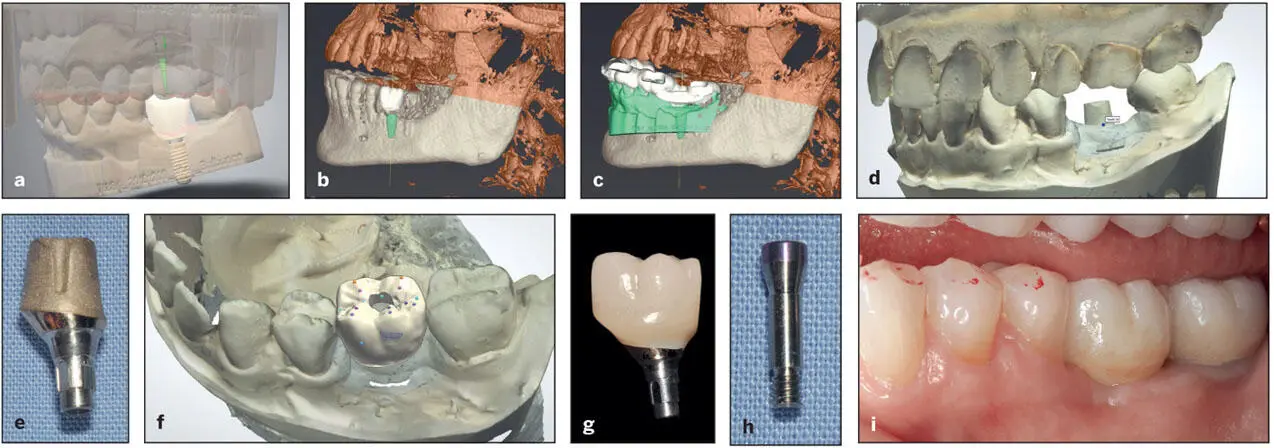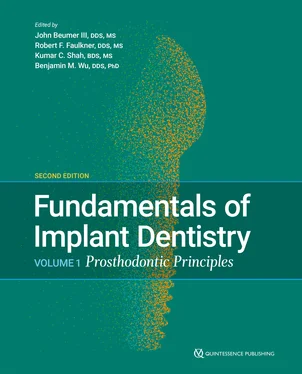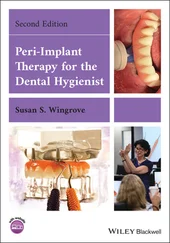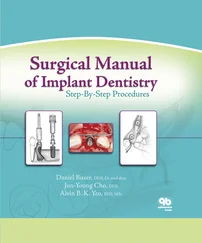
Fig 5-13 A typical workflow using a laboratory stream. (a to c) Conventional impressions were made and articulated. CBCT scan and the data from the scanned casts were merged, and the implant position, length, and diameter were determined. (d and e) The custom abutment was designed and milled. (f and g) The implant crown was designed and milled out of a ceramic material. (h and i) The implant crown was cemented to the abutment outside the mouth and retained with the abutment screw.
Chairside stream
The clinician in this stream can complete all clinical and technical steps at the dental office. This requires the use of chairside scanning and a CAD/CAM unit that is compatible with implant treatment. The protocol involves steps such as digital diagnostic impression taking and implant planning, guide fabrication, digital implant impression, and prosthesis fabrication. In this stream, multiple steps of the restorative workflow are easily combined in one clinical visit, which markedly reduces treatment duration and patient inconvenience. For example, in one visit, scan flags can be attached directly to the implant and scanned by the intraoral scanner. On the generated virtual image, the implant prosthesis is designed and subsequently produced by the chairside CAD/CAM unit. However, the clinician should be very familiar with the setup to ensure proper control of the whole treatment. Despite the advantages of this stream, it has several limitations, such as restriction to single and short-span implant prostheses and loss of artistic customization of the implant restoration by the technician. In addition, due to limitations of the chairside milling unit, the implant prosthesis can only be produced from ceramic, acrylic, or composite resin on a metal insert.
Combined stream (chairside-laboratory stream)
This stream is based on digital completion of the clinical steps at the dental office and fabrication of the prosthesis by a commercial dental laboratory. The clinician records the dental arch by digital impression and transfers the virtual image to a planning software. The clinician also controls the design of all workpieces such as surgical guides, components, and prostheses. Once confirmed by the clinician, the designed object is transferred to the commercial laboratory or a centralized production center, where the guides and the implant prostheses are fabricated. This stream combines the advantages of the previous two streams; however, because the quality of the prosthesis depends solely on the virtual image, the clinician should be ready to manage accuracy errors at the clinic in the form of discrepancy of proximal and occlusal contacts. One of the major advantages of this stream is the involvement of the dental technician in fabricating the prosthesis, which allows more detailed esthetic customization. To enhance the outcome of this protocol, it is recommended to generate a dental cast via 3D printing on which the prosthesis can be fitted and customized in the laboratory. 8
The digital workflow depends on very fluid and continually developing technologies. As a result, the successful application of digital workflows can be ensured by continuing educational participation, review of the dental literature, and collaboration among colleagues undertaken at every opportunity. While digital technology is state of the art, it is still founded on basic prosthodontic principles and as such is merely a set of tools to aid in our overall goals for patient treatment using dental implants. At this juncture, it is impossible to determine what the future of digital technologies will entail with respect to implant dentistry. Certainly, the advances made with digital technologies in all aspects of dentistry have had a significant impact, and evidence suggests that this scenario will continue. Implant dentistry will continue to evolve, and digital technologies will have a substantial role in both planning and delivery of implant modalities for our patients.
Digital impressions
A virtual dental arch is necessary for the digital workflow. Many clinicians who choose to incorporate digital technology with fabrication of a prosthesis record the impression in the customary fashion to generate a master cast that can then be scanned with a laboratory scanner. From this point, the clinician and the laboratory technician can choose the digital workflow for the specific prosthesis fabrication (see Fig 5-13). To date, this has been the most accurate, convenient, and cost-effective process, as the practitioner does not need to invest in the scanner or its maintenance.
As the acquisition cost decreases, the more contemporary method to produce a virtual dental arch is via digital impression. The concept of digital impressions by intraoral scanners has evolved over the past several years, and like many aspects of dentistry, has seen many advancements and improvements. Nevertheless, when digital impression methods were initially introduced, it was a seldom-used procedure relative to the overall various situations that require an impression to record data for dental treatment. Many reasons exist as to the limited use, with cost being the major factor. The initial investment in this technology is significant compared to conventional impression techniques. Other factors that have limited the use of this technology in the past include accuracy of digital impressions, time to record the necessary data, access to various parts of the mouth, limited numbers of dental laboratories that can receive the digital data, techniques required to generate a working cast, and experience and knowledge of the practitioner. Recently, there has been a progressive move to incorporate digital impressions in routine prosthodontic treatment as IOSs became more versatile, more accurate, and quicker (even for recording the whole arch), with easier digital file storage. 6, 58, 59Compared to conventional impressions, digital impressions have the advantage of requiring no tray or impression material usage, which may be more comfortable and convenient to patients. 60From the clinician’s perspective, it may be an economical option after the initial investment. However, with ease of storage, the need to maintain a large database may contribute to the expense. In addition, digital impressions allow for immediate viewing and magnification of the virtual image, which can also be revisited in case of errors within the clinical session. 60Still, digital impressions of implants require removal of the healing abutment and accurate fitting of flags or scan bodies onto the implant platform.
The current literature indicates that digital impressions are suitable for diagnostic purposes where the image is used for planning such as measurements, treatment planning, and diagnostic wax-ups. 48– 50, 61For definitive prosthesis fabrication, the accuracy of digital implant impressions generated intraorally has greatly improved, and some literature has indicated comparable outcomes to conventional techniques. 62– 67However, due to the numerous factors that can influence the accuracy of digital impressions, it appears to be too early to make a rigid recommendation about digital impressions being a suitable substitute to conventional impressions, especially when making full-arch impressions. 60The key influencing factor on the accuracy of the digital impressions is the span of scanning. Consistently, studies have indicated that as the span of scanning increases, the accuracy of the generated image is reduced. 68– 72However, digital impressions generally produce an acceptable quadrant image, while whole-arch scanning is more prone to error compared to conventional impression making and laboratory scanning of the cast. 73, 74
Читать дальше













